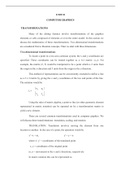Class notes
Computer Graphics docs
- Course
- Institution
This document contains: TRANSFORMATIONS, Two-dimensional transformations, TRANSLATION, SCALING, ROTATION, Three-dimensional transformations, Concatenation, Vector Generation, DDA Algorithm, Bresenham’s Algoritm, Clipping, Line Clipping, Cohen Sutherland Line Clipping Algorithm, Sutherland-Hodgem...
[Show more]



